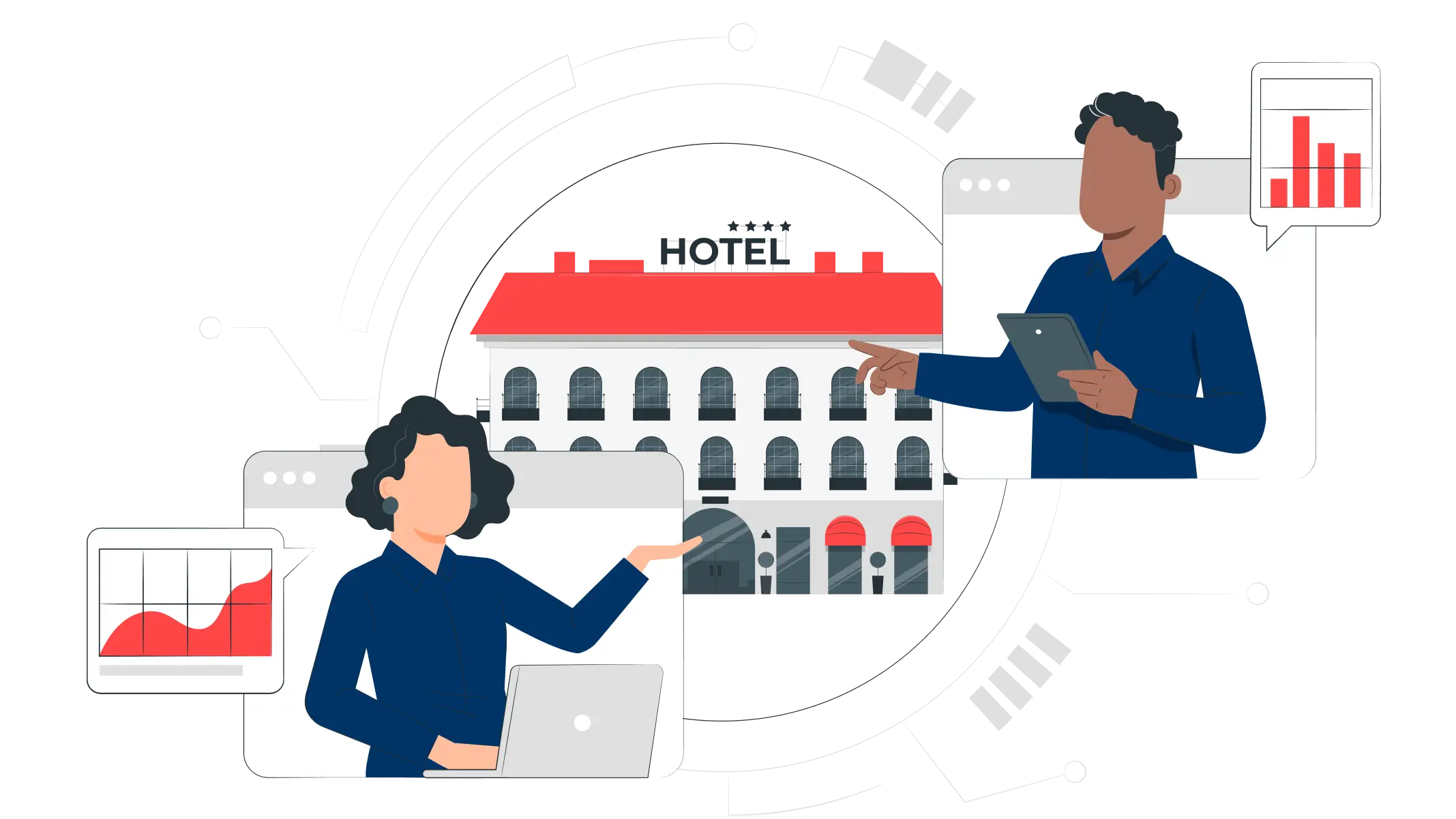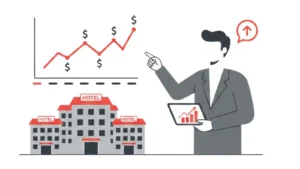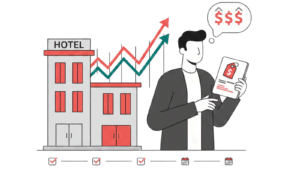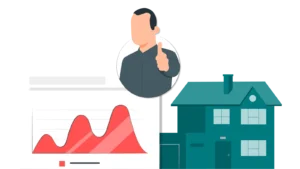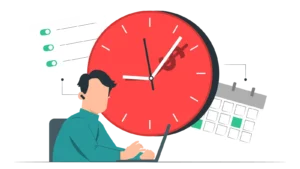Updated : May 27, 2025
In the ever-evolving hospitality industry, staying ahead of the competition is more crucial than ever. As a hotel owner or manager, knowing your competition inside and out is key to thriving in the market. A hotel competitive set analysis isn’t just a buzzword; it’s a strategic necessity. According to a report by STR, hotels that actively engage in competitor analysis can see up to a 20% increase in market share. This process involves examining competitors’ pricing, services, and customer satisfaction to uncover opportunities for differentiation and improvement. By understanding your competitive landscape, you can make informed decisions that enhance your property’s appeal, attract more guests, and ultimately boost revenue.
What Do We Mean by Hotel Competitor Analysis?
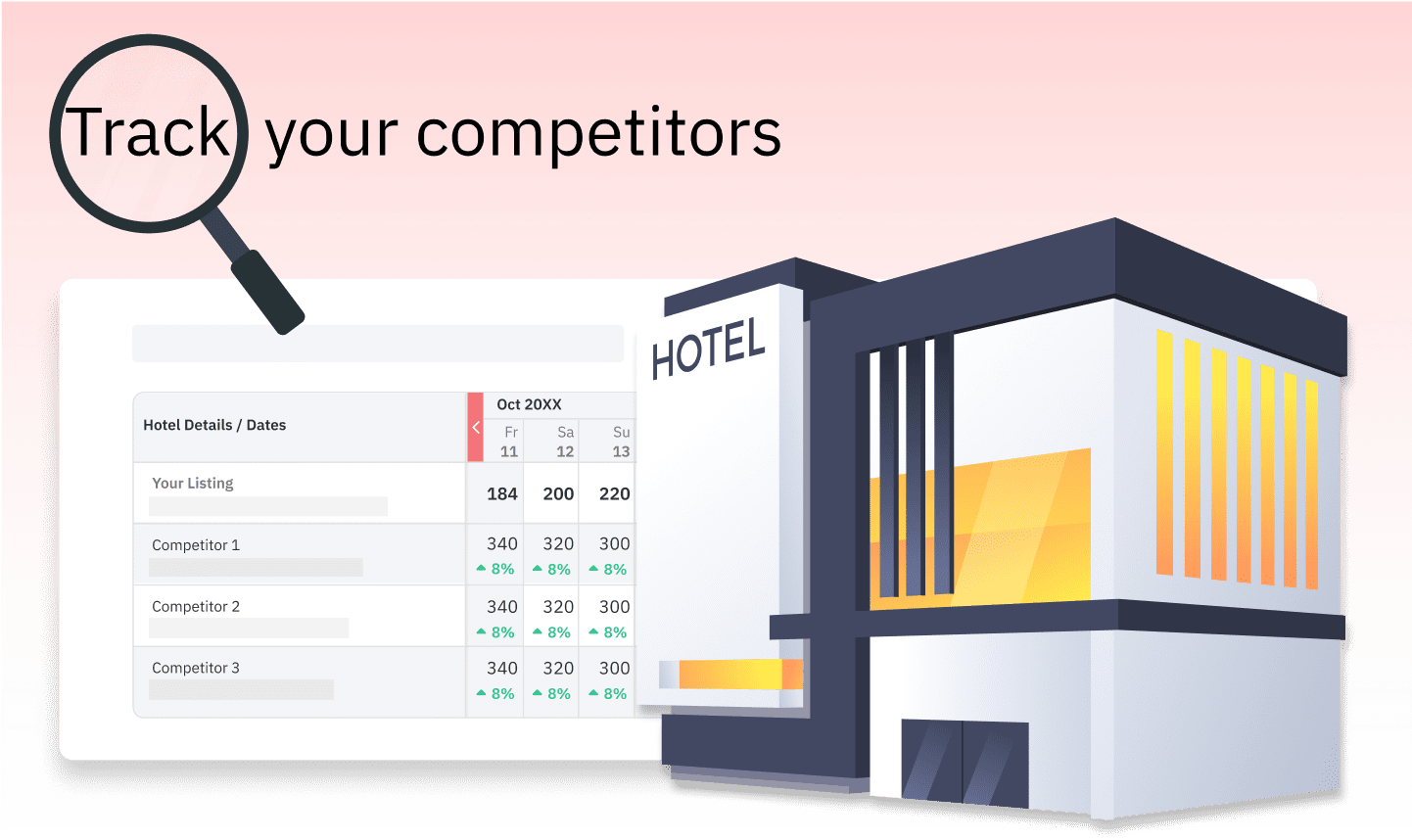
Hotel competitive set analysis is your roadmap to staying competitive in a dynamic industry.
When you conduct a hotel competitor analysis, you’re essentially gathering insights about other hotels in your area that are vying for the same guests. You’re not just looking at who they are but also what they offer, how they price their rooms, and what unique experiences they provide. Doing this gives you a clearer picture of where you stand in the market and identify opportunities to differentiate your hotel.
This process involves more than just a casual glance at their websites or brochures. It means digging deep into their strengths and weaknesses, evaluating their online presence, customer reviews, amenities, and promotional strategies. These elements form the crux of your hotel’s competitive set analysis. It’s like assembling a puzzle where every piece—every insight—helps complete the bigger picture of enhancing your offerings and improving guest satisfaction.
6 Ways How Hotel Competitor Analysis Can Help
By engaging deeply with competitor analysis, you’re not just keeping an eye on the competition—you’re positioning yourself strategically in the market to maximize success.
1. Boost Revenue
Understanding your competition is the first step to boosting your revenue. By conducting a hotel competitive set analysis, you can identify what other hotels in your area charge for similar room types. This insight lets you adjust your pricing strategy effectively, ensuring your rates are competitive yet profitable.
2. Improve Hotel Property Turnover
You want to ensure that your hotel property turnover is optimized. By analyzing competitors, you’ll learn about their occupancy rates and the strategies they use to keep their properties bustling with guests. This knowledge helps you implement tactics that balance your turnover, keeping more rooms occupied and generating steady income.
3. Cater to Diverse Room Types
Different guests have different needs, and analyzing competitors can reveal the variety of room types they offer. From luxury suites in independent hotels to efficient spaces in smart hotels, understanding these offerings allows you to diversify your own room types, appealing to a broader audience and enhancing guest satisfaction.
4. Stay Ahead as an Independent Hotel
Knowing the competitive landscape is crucial for survival and success if you manage an independent hotel. Competitor analysis empowers you to know what big chains are doing so you can carve out a niche and highlight what makes your hotel unique.
5. Enhance Guest Satisfaction
Guest satisfaction is paramount in the hospitality industry. By comparing guest reviews and feedback across competitor hotels, you can identify areas where others excel or fall short, using this information to improve your services and amenities.
6. Emphasize Smart Hotels
Smart hotels are gaining popularity with tech-savvy travelers. Understanding how competitors incorporate technology into their guest experiences will help you decide whether implementing smart technology could be a worthwhile investment for your hotel.
The significance of reporting and analysis in running a hotel cannot be overstated. Regularly conducting hotel competitive set analysis gives you comprehensive insights into market trends, helping you make data-driven decisions that can enhance profitability and operational efficiency.
PriceLabs helps your hotel stay ahead of the market with real-time pricing adjustments.
How?
Make use of PriceLabs’ Competitive Benchmarking & Market Intelligence features and offerings :
- Hotel Data Tab – Monitor the pricing of nearby hotel-style properties, analyze historical rate trends, and gain insights into market demand.
- Neighborhood Data Tab – Analyze short-term rental pricing trends and competitive positioning within your local market.
- Hotel Comp-Set Pricing – Benchmark your rates against a custom competitor set of similar hotels.
Transform your hospitality approach today
Discover actionable strategies tailored for small hotel owners and managers creating unforgettable stays for your guests & expanding revenues for your hotel!
Start your 30-day FREE trial now!How to Run a Hotel Competitor Analysis
1. Identifying Your Competitive Set
Begin by identifying the hotels that directly compete with yours. Consider factors like location, star rating, amenities, and target audience. This forms your “hotel competitive set analysis.” For instance, if you own a boutique hotel in downtown Chicago, your competitive set might include other boutique hotels in the same area.
Practical tip: Look at review sites like TripAdvisor to see which hotels guests are considering alongside yours. The Hoxton in Portland excels at this by regularly updating its competitive set based on guest feedback and market changes.
2. Analyze Pricing Strategies
Pricing is a crucial component of your hotel’s competitive set analysis. Investigate how your competitors price their rooms throughout the year, especially during peak seasons and events. This will give you insights into their revenue strategies. Use tools like STR reports for a detailed view of market trends.
Practical Tip: Subscribe to competitor newsletters to stay informed about their special offers and packages. The Freehand Hotel in Los Angeles uses this approach effectively by adjusting its pricing strategy based on competitor promotions.
3. Evaluate Service Offerings
Examine the unique services and amenities your competitors offer that attract guests. Do they have a standout restaurant or a popular spa? Understanding these elements can help you identify gaps in your offerings or improvement areas.
Practical Tip: Conduct mystery shopping by staying at a competitor’s property to experience their service first-hand. The Ace Hotel in New Orleans regularly sends team members to local competitors to glean insights into service innovations.
4. Monitor Marketing Efforts
Assess how your competitors are marketing themselves online and offline. Look for patterns in their social media engagement, advertising channels, and partnerships with local businesses or influencers. This part of the hotel’s competitive set analysis can reveal effective strategies you might adapt for your marketing plan.
Practical Tip: Use tools like Google Alerts to track mentions of competitor brands online. For example, LINE DC frequently analyzes its competitors’ marketing tactics to refine its own campaigns.
4. Review Their Online Presence
In this digital age, a hotel’s online presence is paramount. Analyze their website design, social media activity, and online reviews on TripAdvisor and Google. A strong online presence often correlates with higher guest engagement and bookings. This aspect of your hotel’s competitive analysis will reveal areas where you can enhance your digital footprint.
5. Assess Guest Experience
Finally, assess the guest experience your competitors offer through reviews and testimonials. What do guests love about these hotels? Are there recurring complaints or praises? This information is gold when it comes to improving your own guest experience strategy.
Tips & Tricks to Stay Ahead of Your Hotel’s Competition
Navigating the competitive landscape of the hospitality industry can be daunting, but with a robust hotel competitive set analysis, you can maintain your edge.Staying ahead isn’t just about reacting; it’s about anticipating the next move in this dynamic industry landscape.
1. Know Your Competitors Inside Out: Dive deep into your hotel competitive set analysis. Understand their strengths and weaknesses, and use this information to identify opportunities for your hotel.
2. Embrace Technology: Utilize the latest technology to streamline operations and enhance guest experiences. Implement smart room features or adopt an efficient property management system.
3. Leverage Social Media & Marketing: Engage with your audience by creating compelling content that resonates with them. Monitor competitors’ social media strategies to spot trends or gaps you can fill. Keep enhancing your digital marketing efforts.
4. Optimize Pricing Strategies: Regularly review your pricing models against your hotel’s competitive set analysis to ensure you’re offering the best value without undercutting your revenues.
5. Enhance Guest Experience: Personalization is key. Use guest data to tailor services that create memorable experiences, encouraging repeat visits and positive reviews.
6. Focus on Sustainability: Implement eco-friendly practices that not only reduce costs but also appeal to environmentally conscious travelers, setting you apart from competitors.
7. Invest in Staff Training: Well-trained staff can significantly elevate the guest experience. Ensure your team is knowledgeable and attentive, fostering a welcoming atmosphere.
8. Offer Unique Amenities: Identify what’s missing in your hotel’s competitive set analysis and introduce unique amenities that cater to niche markets or special interest groups.
9. Utilize Data Analytics: Harness data analytics to make informed decisions about marketing strategies, pricing, and service improvements.

Data supports hotels in novel ways that were not known before. In this context, hotels can maximize their revenues and enhance guest experience.
PriceLabs helps independent hotels automate pricing, stay ahead of competitors, and optimize revenue—without the complexity of an enterprise RMS.
Here’s how
- Always the Right Price – Rates update automatically based on your hotel’s occupancy, competitor pricing, and market demand—no guesswork needed.
- Keep an Eye on the Competition – See the latest competitor pricing, booking trends, and seasonal demand shifts without manual tracking.
- Full Control, Zero Hassle – Set pricing by room type, season, and booking window to match your strategy.
- No More Manual Rate Changes – Automatically apply discounts for last-minute bookings, early reservations, or peak demand without lifting a finger.
- Connects with Your PMS – Works with 170+ Property Management Systems and Channel Managers to update rates across all platforms.
- Automated Reports, Instant Insights – Get real-time updates on occupancy, revenue, and pricing performance – delivered straight to your dashboard.
10. Foster Local Partnerships: Collaborate with local businesses for mutual benefits, such as exclusive offers or joint events, which can attract more guests.
11. Boost Online Presence: Ensure your website is optimized for SEO and mobile-friendly. Regularly update content to remain relevant in search engine results.
12. Stay Abreast of Industry Trends: Keep an eye on industry reports and trends affecting your competitive set, allowing you to adapt quickly and effectively.
13. Solicit Guest Feedback: Actively seek feedback from guests and use it constructively to improve services and address any issues promptly.
14. Innovate Continuously: Innovation should be at the heart of your strategy. Whether it’s through new services or marketing campaigns, keep evolving based on insights from your hotel competitive set analysis.
15. Monitor Reputation Management: Regularly check online reviews and ratings on platforms like TripAdvisor or Google Reviews, responding promptly and professionally to maintain a positive image. We understand how challenging it is to manage a hotel.
Wrapping Up
Conducting a thorough hotel competitive set analysis is not just a one-time task but an ongoing process that can significantly impact a hotel’s success. You can stay ahead in the competitive landscape by consistently monitoring your competitors, understanding their strengths and weaknesses, and adapting your strategies accordingly. Remember, the insights you gain from an effective hotel competitive set analysis will enable you to refine your services, tailor your marketing efforts, and ultimately enhance guest satisfaction. As you move forward, prioritize integrating these findings into your strategic planning, ensuring you remain agile and responsive throughout.


